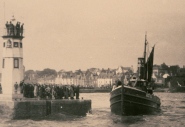Herring Home | Fishing for herring | Back to Expansion of the Herring Fishery
East Coast fishermen fishing further from home
As the herring fisheries expanded, East Coast fishermen fished in larger areas of the East Coast over the summer period. There was also some development of winter fishing. This began in Fife in 1820s, and extended to Caithness and other areas from 1860s. However, winter fishing was usually done locally with the fish sold on the quay, mainly to be consumed fresh. More important was the expansion of their summer fisheries into other areas.

In the 1840s substantial numbers of East Coast fishing boats began to cross to the West of Scotland. They travelled mainly to the Minch and set up bases in Lewis for the period of May and early June. The fishermen had to adapt to the different conditions of the West Coast. Initially they used Stornoway as a base, and then more isolated spots. Where more remote locations were chosen (mainly on the East Coast of Lewis), the whole curing station had to be set up. This would include: building a jetty, bringing salt and barrels from the East Coast of Scotland and providing living quarters for curing staff and crews. The living quarters were often prefabricated huts transported from the mainland East Coast. Coopers came from the East of Scotland, and female gutters came mainly from the islands, but often from some distance away. A similar pattern went on to develop around Barra at the same time of year. At their peak, Barra and Lewis herring fisheries employed 1400 boats, mainly of East Coast origin.

East Coast crews began to move southwards to England for the autumn fisheries. In the 1860s fishing boats from Fife began to go to the fishing in East Anglia. This became an annual occurrence. It was not until the end of the century that boats from other areas joined in this journey.
In the 1880s, Shetland began to be exploited by the East Coast fishermen. Shetland was particularly important because the fishing season lasted from May until September. The East Coast crews and curers were now experienced in exploiting new areas, and the organisation was set up in a similar way to the West Coast. By 1884, a fleet of 900 boats were operating.
Herring Home | Fishing for herring | Back to Expansion of the Herring Fishery